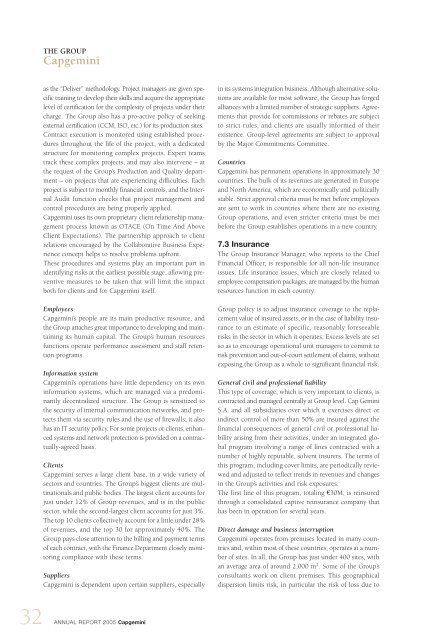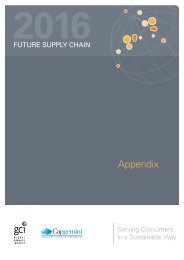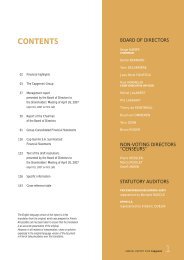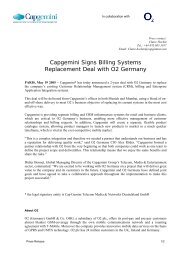You also want an ePaper? Increase the reach of your titles
YUMPU automatically turns print PDFs into web optimized ePapers that Google loves.
32 ANNUAL<br />
THE GROUP<br />
<strong>Capgemini</strong><br />
as the “Deliver” methodology. Project managers are given specific<br />
training to develop their skills and acquire the appropriate<br />
level of certification for the complexity of projects under their<br />
charge. The Group also has a pro-active policy of seeking<br />
external certification (CCM, ISO, etc.) for its production sites.<br />
Contract execution is monitored using established procedures<br />
throughout the life of the project, with a dedicated<br />
structure for monitoring complex projects. Expert teams<br />
track these complex projects, and may also intervene – at<br />
the request of the Group’s Production and Quality department<br />
– on projects that are experiencing difficulties. Each<br />
project is subject to monthly financial controls, and the Internal<br />
Audit function checks that project management and<br />
control procedures are being properly applied.<br />
<strong>Capgemini</strong> uses its own proprietary client relationship management<br />
process known as OTACE (On Time And Above<br />
Client Expectations). The partnership approach to client<br />
relations encouraged by the Collaborative Business Experience<br />
concept helps to resolve problems upfront.<br />
These procedures and systems play an important part in<br />
identifying risks at the earliest possible stage, allowing preventive<br />
measures to be taken that will limit the impact<br />
both for clients and for <strong>Capgemini</strong> itself.<br />
Employees<br />
<strong>Capgemini</strong>’s people are its main productive resource, and<br />
the Group attaches great importance to developing and maintaining<br />
its human capital. The Group’s human resources<br />
functions operate performance assessment and staff retention<br />
programs.<br />
Information system<br />
<strong>Capgemini</strong>’s operations have little dependency on its own<br />
information systems, which are managed via a predominantly<br />
decentralized structure. The Group is sensitized to<br />
the security of internal communication networks, and protects<br />
them via security rules and the use of firewalls; it also<br />
has an IT security policy. For some projects or clients, enhanced<br />
systems and network protection is provided on a contractually-agreed<br />
basis.<br />
Clients<br />
<strong>Capgemini</strong> serves a large client base, in a wide variety of<br />
sectors and countries. The Group’s biggest clients are multinationals<br />
and public bodies. The largest client accounts for<br />
just under 12% of Group revenues, and is in the public<br />
sector, while the second-largest client accounts for just 3%.<br />
The top 10 clients collectively account for a little under 28%<br />
of revenues, and the top 30 for approximately 40%. The<br />
Group pays close attention to the billing and payment terms<br />
of each contract, with the Finance Department closely monitoring<br />
compliance with these terms.<br />
Suppliers<br />
<strong>Capgemini</strong> is dependent upon certain suppliers, especially<br />
REPORT <strong>2005</strong> <strong>Capgemini</strong><br />
in its systems integration business. Although alternative solutions<br />
are available for most software, the Group has forged<br />
alliances with a limited number of strategic suppliers. Agreements<br />
that provide for commissions or rebates are subject<br />
to strict rules, and clients are usually informed of their<br />
existence. Group-level agreements are subject to approval<br />
by the Major Commitments Committee.<br />
Countries<br />
<strong>Capgemini</strong> has permanent operations in approximately 30<br />
countries. The bulk of its revenues are generated in Europe<br />
and North America, which are economically and politically<br />
stable. Strict approval criteria must be met before employees<br />
are sent to work in countries where there are no existing<br />
Group operations, and even stricter criteria must be met<br />
before the Group establishes operations in a new country.<br />
7.3 Insurance<br />
The Group Insurance Manager, who reports to the Chief<br />
<strong>Financial</strong> Officer, is responsible for all non-life insurance<br />
issues. Life insurance issues, which are closely related to<br />
employee compensation packages, are managed by the human<br />
resources function in each country.<br />
Group policy is to adjust insurance coverage to the replacement<br />
value of insured assets, or in the case of liability insurance<br />
to an estimate of specific, reasonably foreseeable<br />
risks in the sector in which it operates. Excess levels are set<br />
so as to encourage operational unit managers to commit to<br />
risk prevention and out-of-court settlement of claims, without<br />
exposing the Group as a whole to significant financial risk.<br />
General civil and professional liability<br />
This type of coverage, which is very important to clients, is<br />
contracted and managed centrally at Group level. Cap Gemini<br />
S.A. and all subsidiaries over which it exercises direct or<br />
indirect control of more than 50% are insured against the<br />
financial consequences of general civil or professional liability<br />
arising from their activities, under an integrated global<br />
program involving a range of lines contracted with a<br />
number of highly reputable, solvent insurers. The terms of<br />
this program, including cover limits, are periodically reviewed<br />
and adjusted to reflect trends in revenues and changes<br />
in the Group’s activities and risk exposures.<br />
The first line of this program, totaling €30M, is reinsured<br />
through a consolidated captive reinsurance company that<br />
has been in operation for several years.<br />
Direct damage and business interruption<br />
<strong>Capgemini</strong> operates from premises located in many countries<br />
and, within most of these countries, operates at a number<br />
of sites. In all, the Group has just under 400 sites, with<br />
an average area of around 2,000 m 2 . Some of the Group’s<br />
consultants work on client premises. This geographical<br />
dispersion limits risk, in particular the risk of loss due to















